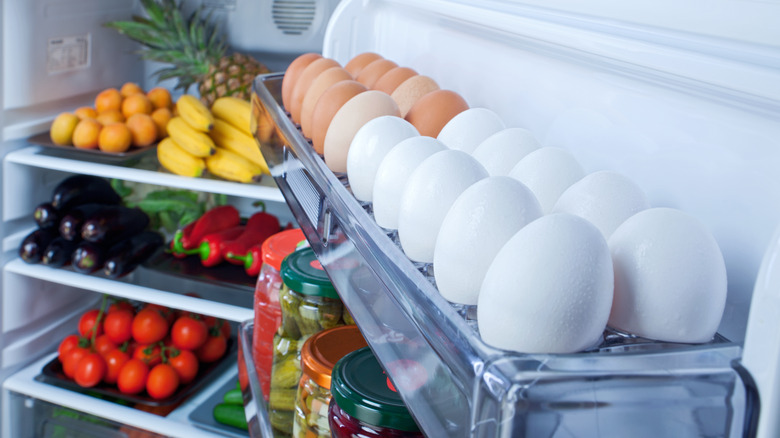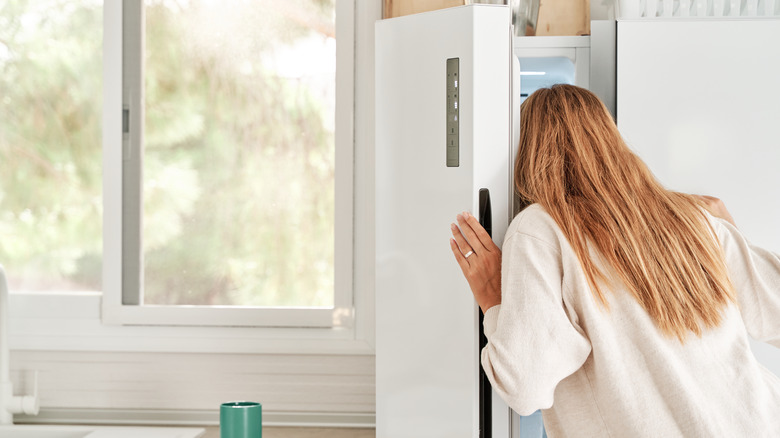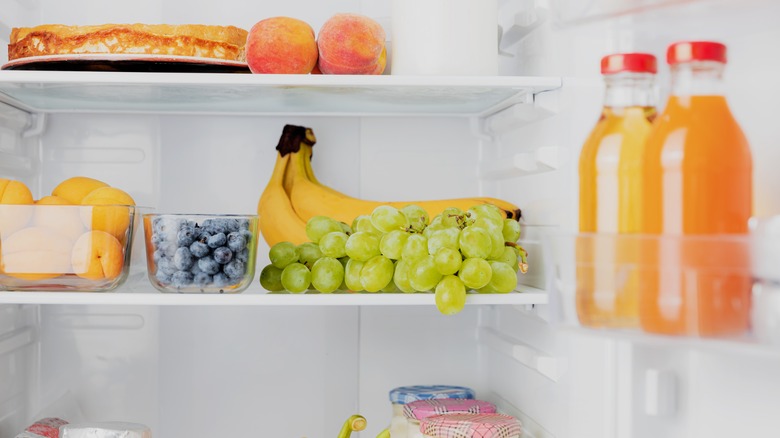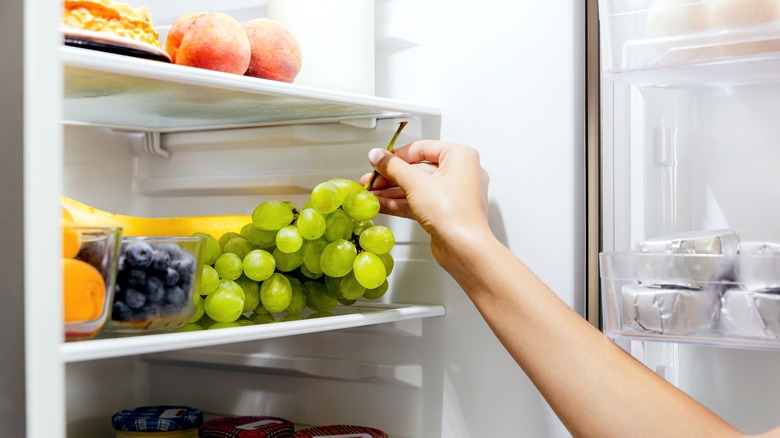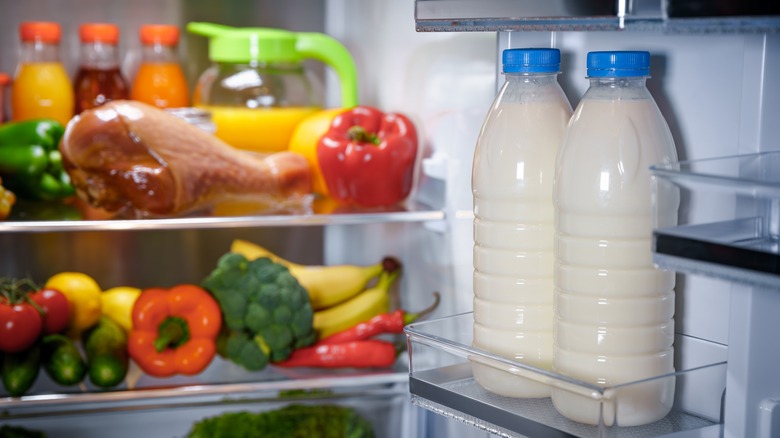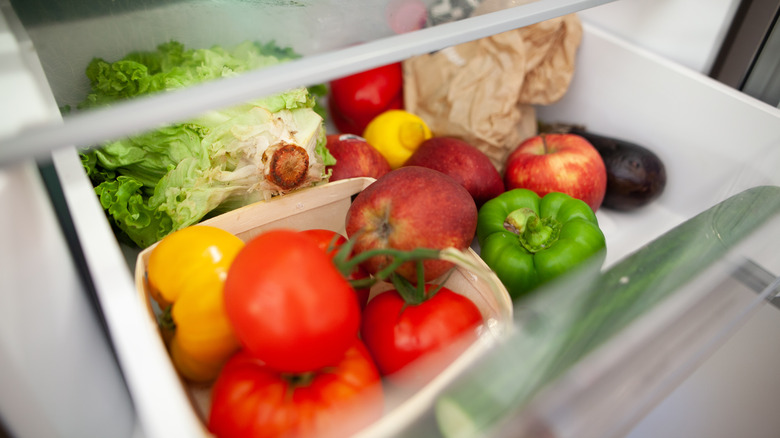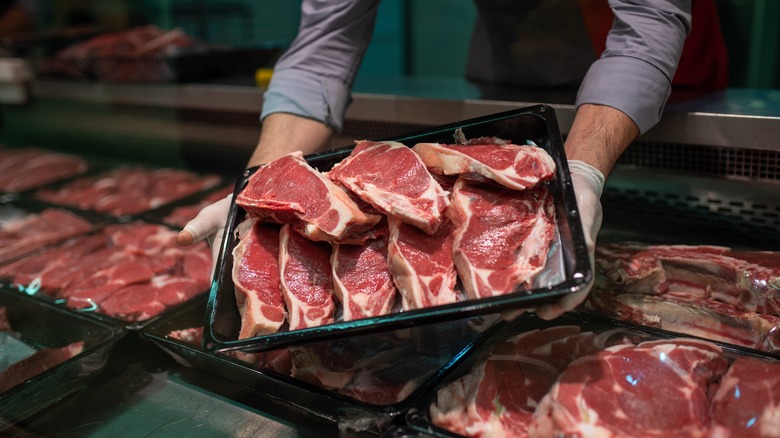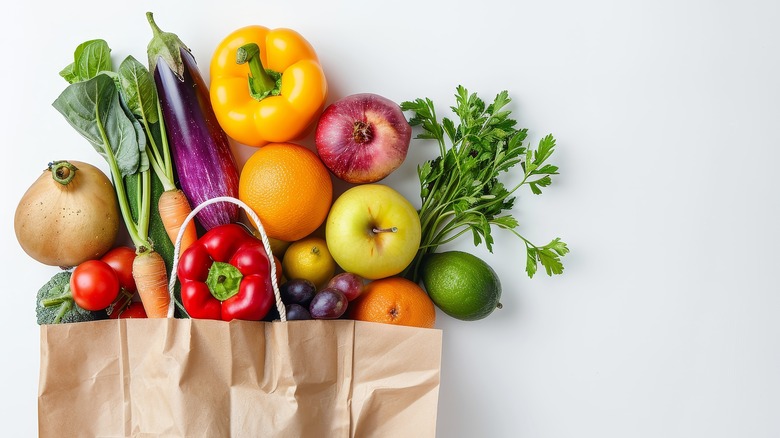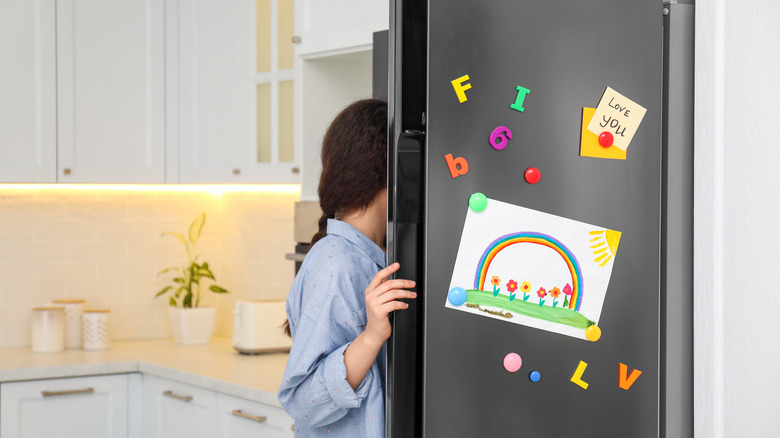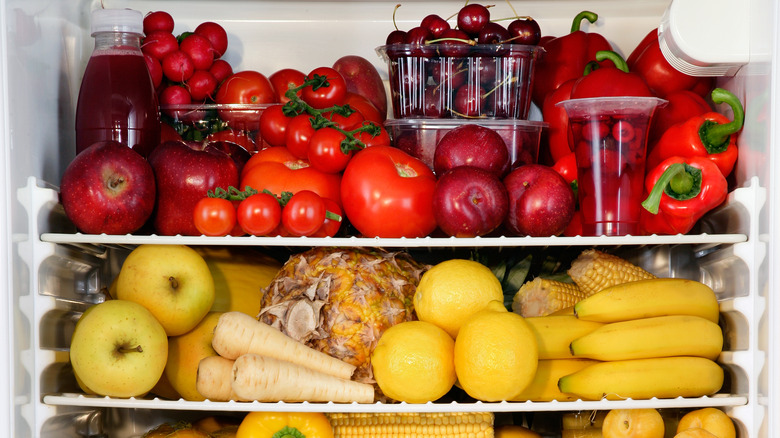Chef Tells Us The Dos And Don'ts Of The Fridgescaping Trend
There has been boho chic, Bauhaus, and a myriad of other home décor trends that have taken the internet by storm this year. The newest one is all about maximizing your décor in areas of your home you would never think to — like your refrigerator. Fridgescaping is the most recent trend on social media, and its goal is to romanticize your fridge by doing some landscaping on its shelves.
Participants in the trend will add plants, flowers, rocks, picture frames, and various other décor items to their fridge to make it look more "aesthetic." Very few people, however, are considering whether this level of home beautification is practical for produce storage and cooking purposes. Thankfully, we spoke to Lydia Yeakel, corporate executive chef at Violife, who is a leader in the dairy-free products development arena, and she gave us insight into what professional chefs think of the fridgescaping trend.
According to Chef Yeakel, you do not have to choose between aesthetics and freshness in your fridge. There are tips and insights to food organization and storage that can help you decide whether fridgescaping is right for you, and prevent food spoilage while you participate in this trend. This article will give you the inside scoop so you can decide if you are ready to take your fridge to the next level.
Fridgescaping may not be productive if you cook a lot
Regardless of what home décor trends are going on, the kitchen is always the place where home cooks shine. Fridgescaping might prove to be more of a hindrance on your cooking experience if you are frequently in and out of your fridge. As Chef Lydia Yeakel of Violife says, fridgescaping can slow you down in the kitchen.
"When you're in and out of the fridge all the time, you need a setup that makes it easy to grab what you need quickly and keeps your food fresh — something fridgescaping doesn't always allow for," says Chef Yeakel. With flower pots and picture frames and decorative pebbles in your fridge, there is more of a risk of knocking something over or causing a spill as you are moving around your kitchen and trying to grab ingredients for dinner out of your fridge.
While fridgescaping as a whole does not necessarily scream practical, it can be especially impractical for home cooks, and might just not be worth the hassle. You can still organize your fridge in aesthetically pleasing ways, but if you are going to be cooking a lot, you may want to leave out the extra non-food household items.
Prioritize practicality over aesthetics
Fridgescaping is already not about practicality and all about making your fridge look pretty, so you have to be extra intentional about mixing in a little bit of well-thought-out organization to make participating in this trend more advantageous for you. You can start by choosing the right container for your various food items.
According to Lydia Yeakel, one of the best types of storage containers to use are clear containers, because you can easily see what is inside. In this way, you can keep track of what produce you have to work with in your fridge and keep an eye on it to note if it may be leaning toward spoilage. These clear containers work for aesthetics, too — you can organize your foods by color if that is your style, and the clear containers will allow these colors to shine through while also protecting your produce.
Another way to add style while keeping things practical is through using glass containers or sleek baskets. You can still keep similar food items in proximity to each other, so these types of containers will also be functional while beautifying your fridge. "Remember, practically should always come first," says Chef Yeakel. "Your fridge still needs to work for you, not just look good."
Display colorful fruits, not your greens
Avoid making food storage mistakes by using decorative baskets and other containers to store your food. Some produce has to be stored differently than others in order to prevent spoilage. For example, hardy fruits and vegetables like beets, apples, lemons, grapefruits, and other citrus can be stored in an open container like a basket. These fruits and veggies also work well for aesthetics, since they are usually quite vibrant in color.
However, there are more delicate items that should always be placed in sealed containers for storage. Herbs and greens like lettuce, parsley, cilantro, and more should be sealed to prevent wilting and browning. These are good items to use clear containers for, as you can keep them sealed while also keeping them visible to constantly check for freshness.
Another great way to store delicate produce is in bags — but not that plastic ones from the grocery store. Instead, you can use cotton or linen produce bags to maximize the freshness of your produce.
Don't change the temperature of your fridge
When you start to add plants, flowers, and other non-food household items to your fridge, it can get tempting to alter the temperature of your fridge to make sure these items do not get ruined. However, this would be a mistake for the food you store in your fridge, because there is a proper temperature to keep your fridge at. According to Chef Lydia Yeakel, this temperature is below 40 F.
And although fridgescaping is all about décor, keep in mind that adding non-food items to your fridge can alter the temperature, too. If certain items are too tall or taking up too much space and blocking a vent, this can prevent cold air from flowing through the fridge and cause temperature fluctuations, which is not ideal for your food items. So, if you are adding décor to your fridge, be mindful of its size and where you place it.
In addition to keeping the proper temperature, it is important to store various food items in the proper part of your refrigerator. Since the back of the fridge is usually colder than the front, according to Chef Yeakel, you should store highly perishable items like dairy products close to the back of the fridge. Other highly perishable items include meat and poultry — which should be kept separate from other foods, according to Chef Yeakel — and chopped fruits or vegetables.
Stay on top of your display to watch for food spoilage
The best part about making your fridge look pretty on the inside is that you can spend all day looking at how much you have beautified it — and you should. Paying extra attention to your display is how you will be able to find food spoilage when it happens, so that food is not left to rot in your fridge. When using glass containers or produce bags, you can look for browning on your greens, or dents or pockets of rot on your more firm produce, like tomatoes or cucumbers.
A great way to watch for food spoilage is to follow the first in, first out rule of food storage. If you have multiple heads of broccoli, multiple bunches of cilantro, or more than one of anything in your fridge, you should try to keep track of which one you purchased first, so you can use that one first when cooking. It helps to put the oldest produce in the front of the fridge, so you know to grab that first.
According to Lydia Yeakel, it is important to use older items first in order to participate in the fridgescaping trend safely. Not only will this allow you to eat the most fresh produce items, but it will also keep your fridge looking as aesthetic as the first day you decorate it.
Know which foods to keep in their original containers
Although you can mostly participate in the fridgescaping trend while also keeping your food safe, there are some food items that just should not be put into new, more visually appealing containers. Raw meat is one of them — according to Chef Lydia Yeakel of Violife, "Raw meat should always remain in its original packaging or be stored in sealed containers on the bottom shelf to prevent cross-contamination." Another raw meat rule is that it should also be kept separate from other foods, as if any cross-contamination occurs, you could be at risk for food-borne illnesses that could be avoided by maintaining a proper food storage system.
Dairy products should also remain in their original containers. This way, you can more easily track the expiration date of your milk or cheese products without having to write it down or remember it yourself, as you would if you changed the container. This includes eggs as well, which should be kept in their original cartons so they do not crack or break. Egg cartons also do well to protect the eggs from absorbing any odors of the surrounding food items in your fridge, so the eggs remain fresh and pure.
Use produce-saving containers or bags for your fruits and veggies
The plastic grocery store bags you purchase your fruits and vegetables in are not ideal for long-term produce storage. Often, plastic causes perishable foods to spoil a bit quicker, and plastic can also leak chemicals into your food that are not safe for consumption. Using a cloth or linen produce bag to store your fruits and vegetables is ideal because it reduces the amount of perspiration on your produce, which means they will not spoil as early as they would in the plastic.
Using cloth produce bags is even sustainable, as you are using less plastic in general, and you are helping reduce food waste by elongating the life of your food items. You can even bring your cloth food bags with you to the supermarket and shop with those instead of the grocery store plastic bags. The safest material for produce bags is organic cotton, and it is always best to use one bag for one type of produce item (i.e., one bag for tomatoes, one bag for apples, etcetera). Plus, cotton produce bags could give your fridge a sort of boho chic look so you can still stay on trend.
Be careful when adding non-food items to your fridgescape layout
The most bizarre part about the fridgescaping trend is that household items are added into a fridge as decoration, including picture frames and plants. Although this is part of the fun for many of the participants in the trend, Chef Lydia Yeakel of Violife says storing non-food items in the fridge can potentially be harmful to produce.
"Flowers and plants may introduce bacteria, mold, or insects," Chef Yeakel says. "Rocks or decorative items could take up valuable space needed for proper air circulation." This goes back to the point of not altering the temperature of your fridge; if air is not properly circulating in the fridge, food items are more at risk of spoilage.
If you are adding these non-food items to your fridge, it is important to keep them properly cleaned. Dust and disinfect these items as much as you would if they were sitting on a living room mantle — and maybe even more often, because the risk of food contamination is greater when these items are around perishable, refrigerated produce.
Here's how to fridgescape like a professional chef would
If you want to participate in the fridgescaping trend without compromising the freshness of your food products, Chef Lydia Yeakel, corporate executive chef at Violife, gave us the inside scoop to the steps you should take. According to Chef Yeakel, professional chefs organize their refrigerators by shelves.
On the top shelf, you should store ready-to-eat foods (like rotisserie chicken, tossed salads, and any premade foods you may find in a grocery store), drinks, and leftovers from last night's dinner. On the middle shelves is where you can store dairy, eggs, and deli meats; if you have a dairy-free diet or you keep both dairy and non-dairy items in your fridge, Chef Yeakel recommends storing those non-diary items in the same areas you would keep their dairy counterparts. "This approach combines aesthetic appeal with proper food storage practices while accommodating various dietary preferences," says Yeakel.
Raw meats should be stored on the bottom shelves to prevent any dripping onto the other shelves. In the fridge drawers, you can store your fruits and vegetables to keep them fresher longer — but be sure to store these separately in accordance with the tips above. Finally, your refrigerator door can hold condiments, cream cheese, and similar items. By following these tips, you can safely and strategically stay on top of the latest trends.
